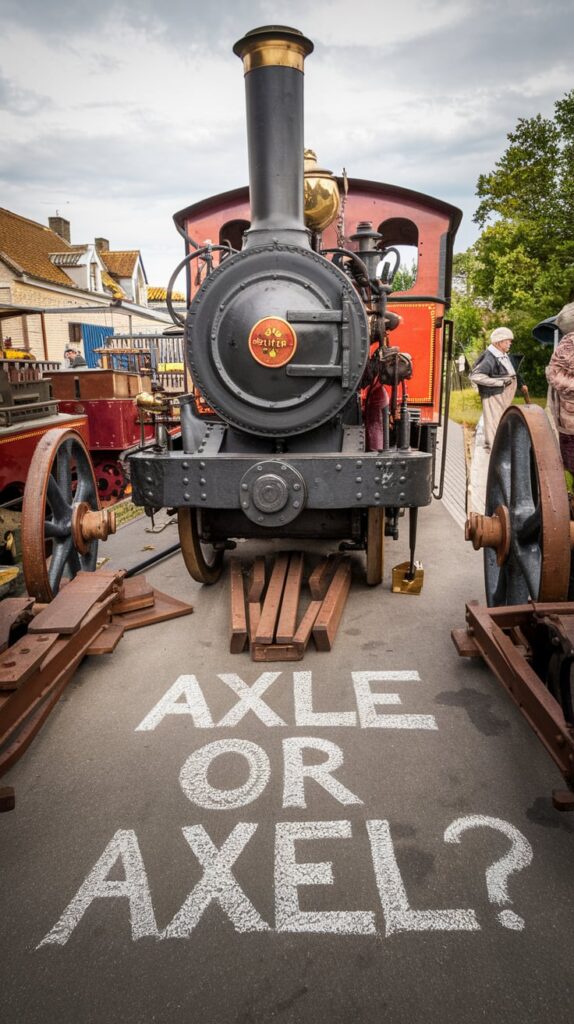What’s the Difference?
When exploring the English language, it’s common to encounter words that sound alike yet carry vastly different meanings. A prime example of this is “axle” or “Axel.”
Understanding the differences between axle or Axel is essential for anyone looking to enhance their vocabulary and communication skills. This article will delve into the meanings, origins, contexts, and more, ensuring that by the end, you can confidently distinguish between axle or Axel.
read more : Plural of Oasis: Exploring Its Meaning, Usage, and More – Grammar Beacon

What Do Axle and Axel Mean?
To begin with, let’s define both terms clearly. Understanding what axle or Axel signify is the first step in using them correctly.
Axle
The term “axle” refers to a crucial mechanical component that serves as a central shaft for rotating wheels or gears. It connects two or more wheels, allowing them to rotate together,
which is fundamental for vehicles and various machinery. Without an axle, a vehicle would lack the necessary mechanism for movement, making it impossible for the wheels to turn effectively.
Importance of the Axle
- Stability: The axle plays a vital role in maintaining the stability of a vehicle.
- Load-Bearing: Axles bear the weight of the vehicle and any additional cargo.
- Performance: The design and material of an axle can significantly affect a vehicle’s performance and handling.
Examples of Axle in Context:
- “The axle of the car was damaged, causing a loss of control while driving.”
- “Engineers designed the axle to withstand heavy loads and ensure safety.”
Axel
In contrast, “Axel” refers to a specific figure skating jump. Named after the Norwegian skater Axel Paulsen, who first performed it in the late 1800s, the Axel involves taking off from one foot, rotating in the air,
and landing on the opposite foot. This jump is notable for being one of the most challenging maneuvers in figure skating, requiring a combination of strength, technique, and artistry.
read more : What Does Wytb Meaning in Texting? – Grammar Beacon

Importance of the Axel
- Skill Level: Mastering the Axel is often a benchmark for figure skaters, representing a significant achievement.
- Performance Impact: Successfully landing an Axel can greatly influence a skater’s score in competitions.
Examples of Axel in Context:
- “She attempted a double Axel during her routine, impressing the judges with her technique.”
- “Landing a triple Axel is a monumental achievement for any competitive skater.”
Origins of Axle and Axel
Understanding the origins of axle or Axel provides further insight into their meanings and usage.
Axle
The word “axle” originates from the Latin word “axilla,” meaning “little axis.” The term evolved through Old French and made its way into Middle English, reflecting the mechanical significance of this component throughout history.
The axle has been integral to transportation and machinery since the dawn of engineering.
Axel
On the other hand, “Axel” derives its name from Axel Paulsen, a prominent figure skater in the late 19th century. Paulsen was the first to execute this particular jump, which now carries his name.
The term embodies both his legacy and the technical prowess required to perform the jump.
Axle vs Axel: The Differences
Key Differences
The differences between axle and Axel can be summarized as follows:
- Functionality: The axle serves a mechanical function, while the Axel represents a specific athletic maneuver.
- Context: Use axle when discussing machinery, vehicles, or engineering. In contrast, use Axel in contexts related to figure skating.
- Spelling and Pronunciation: The two words, while phonetically similar, have distinct spellings and pronunciations. The “a” in axle is pronounced like “ah,” while Axel has a short “a” sound.
Can Someone Write ‘Axle’ Instead of ‘Axel’?
Mixing up “axle” or “Axel” can lead to significant misunderstandings. For instance, saying, “She landed an impressive axle” implies a mechanical feat rather than a skating jump. Clarity in language is crucial, especially in specialized fields.
read more : What Does “Iicyify” Meaning? Guide with Examples – Grammar Beacon
Examples in Context
To better illustrate the use of axle and Axel, let’s delve into specific examples in various contexts.
Axle
Here are more detailed scenarios involving axle:
Automotive Mechanics:
- “The mechanic inspected the axle for wear and tear, knowing its importance in the vehicle’s operation.”
- “An improperly aligned axle can cause uneven tire wear, affecting performance and safety.”
Engineering Applications:
- “In designing machinery, engineers often focus on the strength and durability of the axle to prevent failure.”
- “The axle supports various components in an assembly line, making it vital for operational efficiency.”
Everyday Life:
- “When riding a bike, the axle ensures that the wheels turn smoothly, providing a better riding experience.”
- “The axle of a toy car can often break, rendering the toy unusable if not properly maintained.”
Axel
Now, let’s explore examples of Axel in the context of figure skating:

Competitions:
- “During the championship, she executed a flawless Axel, earning high scores from the judges.”
- “His routine included a triple Axel, a move that left the audience in awe.”
Training:
- “Aspiring figure skaters spend countless hours perfecting their Axel, knowing its importance in competitions.”
- “Coaches often emphasize the need for proper technique when practicing the Axel to prevent injuries.”
Skating Culture:
- “The Axel has become a defining element of a skater’s repertoire, showcasing their skill and dedication.”
- “Videos of skaters performing the Axel often go viral, highlighting the beauty and athleticism of the sport.”
Understanding Axles in Greater Detail
Types of Axles
There are several types of axles, each serving a unique purpose. Understanding these can enhance your appreciation for how they function in vehicles and machinery.
Live Axle:
- A live axle drives the wheels and is essential for transmitting power from the engine to the wheels. This type of axle is often found in rear-wheel-drive vehicles.
Dead Axle:
- Unlike a live axle, a dead axle does not transmit power. Instead, it supports the vehicle’s weight. Dead axles are common in trailers and some types of machinery.
Stub Axle:
- Stub axles are often utilized in the front axles of vehicles. They support the wheel hub and are crucial for steering.
Importance of Axles in Engineering
The significance of axles extends beyond just vehicles. Here’s why they matter in engineering:
- Safety: A reliable axle is crucial for safe vehicle operation. If an axle fails, it can lead to accidents and injuries.
- Performance: The design of an axle can impact a vehicle’s handling and responsiveness. Engineers often work to optimize axle design for better performance.
- Maintenance: Regular inspection and maintenance of axles can prolong their life and enhance vehicle safety.
Understanding Axels in Greater Detail
Types of Axels
Just as there are different types of axles, there are also variations of the Axel jump in figure skating:
Single Axel:
- The foundation of all Axel jumps, involving one rotation. This is often where skaters begin their journey into mastering more complex jumps.
Double Axel:
- A more advanced maneuver, the double Axel involves two rotations in the air. This jump requires greater height and speed.
Triple Axel:
- The pinnacle of the Axel family, the triple Axel is renowned for its difficulty. Successfully landing a triple Axel is a significant milestone in a skater’s career.
Importance of the Axel in Skating
The Axel jump is not only a test of skill but also a significant part of a skater’s identity. Here’s why mastering the Axel matters:
- Technical Skill: Performing an Axel showcases a skater’s technical prowess and their ability to execute complex moves under pressure.
- Competition Readiness: Skaters are often judged on their ability to land jumps like the Axel, which can greatly influence their scores and rankings in competitions.
Engaging the Reader
As you absorb this information, consider how the distinctions between axle or Axel apply to your life. Here are some thought-provoking questions:
- Have you ever thought about the engineering that goes into the axle of a vehicle?
- What does it take to master an Axel in figure skating, and how does it reflect a skater’s dedication to their craft?
These questions not only engage your curiosity but also deepen your understanding of these terms.
The Cultural Significance of Axle and Axel
Both axle and Axel have cultural significance in their respective fields. In engineering, the axle represents innovation and the advancements that make modern transportation possible. In figure skating, the Axel symbolizes artistry
, athleticism, and the pursuit of excellence.
In Engineering
The evolution of the axle over the years showcases technological advancements in the automotive industry. Innovations in materials and design have led to stronger, lighter axles that improve vehicle performance and safety.
read more : What Kind of vs What Kinds of – Grammar Beacon

In Figure Skating
The Axel jump has become a hallmark of figure skating competitions. It represents the blend of strength, grace, and technical ability that defines the sport. Skaters who successfully perform the Axel often gain recognition and respect within the skating community.
Conclusion: A Final Look at “Axle or Axel”
In conclusion, the distinction between axle and Axel is vital for clear communication and understanding. Knowing that axle refers to a mechanical component while Axel denotes a figure skating jump allows you to use these terms appropriately in conversation.

Key Takeaways:
- Axle: A mechanical component critical for the operation of vehicles and machinery.
- Axel: A challenging figure skating jump that requires skill and technique.
- Understanding these terms enriches your vocabulary and enhances your communication skills.
Sources
- Merriam-Webster Dictionary
- Oxford English Dictionary
- National Figure Skating Association
With this in-depth understanding, you’ll never confuse axle and Axel again. Whether discussing mechanical engineering or the elegance of figure skating, you’ll be well-equipped to express yourself clearly and accurately.

James Logan is a seasoned blogger and language enthusiast behind Grammar Beacon. With years of experience in grammar and writing, James shares his expertise through insightful and engaging content. His passion for clear communication and linguistic precision shines in every post, making complex grammar concepts accessible and enjoyable for readers. Follow James for expert advice and tips to refine your writing skills.







